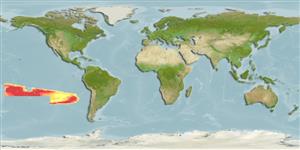>
Aulopiformes (Grinners) >
Scopelarchidae (Pearleyes)
Etymology: Scopelarchoides: Greek, skopelos = a lantern fish + Greek, archos = anus + Greek, oides = similar (Ref. 45335); climax: Named for the Climax expeditions to the central Pacific Ocean and for John McGowan, leader of this expeditions, and for the scientists and crews participating in these voyages..
Environment: milieu / climate zone / depth range / distribution range
Ecologia
marino batipelagico. Deep-water
Distribuzione
Stati | Aree FAO | Ecosystems | Presenze | Point map | Introduzioni | Faunafri
Eastern Central Pacific: near the Tubuai Group, between 24.5-25°S and around 155°W.
Size / Peso / Age
Maturity: Lm ? range ? - ? cm
Max length : 9.9 cm SL maschio/sesso non determinato; (Ref. 40783)
Short description
Chiavi di identificazione | Morfologia | Morfometria
Raggi dorsali molli (totale) : 7 - 8; Raggi anali molli: 25 - 27; Vertebre: 49.
Life cycle and mating behavior
Maturities | Riproduzione | Spawnings | Egg(s) | Fecundities | Larve
Johnson, R.K., 1974. Five new species and a new genus of alepisauroid fishes of the Scopelarchidae (Pisces: Myctophiformes). Copeia 1974(2):449-457. (Ref. 40783)
IUCN Red List Status (Ref. 130435)
Threat to humans
Harmless
Human uses
Pesca: di nessun interesse
Strumenti
Special reports
Download XML
Fonti Internet
Estimates based on models
Phylogenetic diversity index (Ref.
82804): PD
50 = 0.5313 [Uniqueness, from 0.5 = low to 2.0 = high].
Bayesian length-weight: a=0.01000 (0.00244 - 0.04107), b=3.04 (2.81 - 3.27), in cm total length, based on all LWR estimates for this body shape (Ref.
93245).
Trophic level (Ref.
69278): 4.1 ±0.7 se; based on size and trophs of closest relatives
Fishing Vulnerability (Ref.
59153): Low vulnerability (10 of 100).
